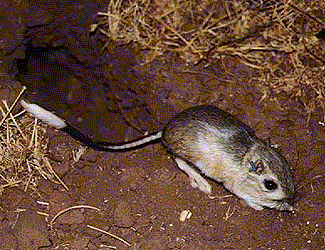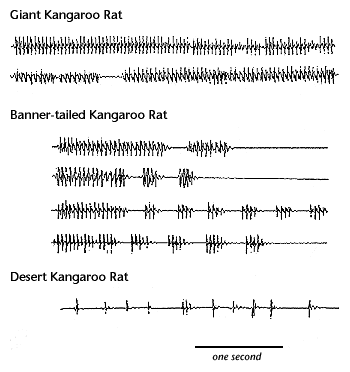Acoustical Society of America
133rd Meeting Lay Language Papers
Comparison of Low-frequency Communication by Footdrumming in Three Species of Solitary, Desert Rodent, Kangaroo Rats
Jan A. Randall - jrandall@sfsu.edu
Department of Biology, San Francisco State University
San Francisco, California 94132
Session 4pAB, Low Frequency Bioacoustics
Presented Thursday afternoon, June 19, 1997
133rd ASA Meeting, State College, PA
Embargoed until June 19, 1997
Introduction
Drumming the feet on the ground to create mechanical vibrations is an important means of communication in open, desert environments and occurs in the contexts of spacing, competition and predator defense. Footdrumming is widespread among desert rodents and has evolved in several different groups around the world, including kangaroo rats from North America and gerbils from North and South Africa and Asia. All of these rodents have specially adapted ears for reception of the low-frequency vibrations transmitted via both the air and seismically through the ground.
About Kangaroo Rats
Kangaroo rats are solitary, desert rodents that are active only during the night. Of the 20 different species of kangaroo rat in the United States, I have compared footdrumming behavior in these three:
- Banner-tailed(Dipodomys spectabilis). These animals live in the U.S. Southwest (SE Arizona and New Mexico) in desert scrub and arid grassland habitats.
- Giant (D. ingens). This federally-listed endangered species has a limited range in the arid grasslands of the San Joaquin Valley of California.
- Desert (D. deserti). This is the most desert-adapted of the three species with burrows limited to sand dunes in the Mojave desert of California and Nevada.
A picture of the Banner-tailed Rat, with the white 'banner' on its tail, is shown below.

|
|
Banner-tails live alone in territories consisting of large dirt mounds in which they store large caches of seeds, their main food source. Mounds are essential for survival and reproduction and are passed from one generation of rat to another. The rats defend their mounds from all intruders by footdrumming and chasing.
This rat is eating seeds at a burrow entrance to his mound.
Notice the metal tag with blue reflectant tape attached to the rat's ear. I use these markers to identify individual rats as they forage away from their burrows at night.
|
Footdrumming Signals
Each time a rat hits a hind foot on the ground is a footdrum. Footdrums are grouped into short bursts called footrolls, and several footrolls can be combined to make a sequence. Analysis of footdrumming recordings revealed that the three species have distinctly different footdrumming patterns. The desert kangaroo rat has a simple pattern of single drums at a rate of about 4 drums/second. The giant kangaroo rat drums very long footrolls that can average over 100 drums at a rate of 18 drums/second. The banner-tailed varies the number of footdrums in the first footroll and the footrolls in a sequence to drum individually distinct footdrumming patterns.
Here's a chart showing species differences in footdrumming signals.
|
The top two signal traces are typical of the long footrolls of the giant kangaroo rat. This species alternately drums with a single foot.
The next four traces show the individually distinct footdrumming signatures of four different banner-tailed kangaroo rats of both sexes. The rats drum with the tips of both hind feet while balancing on the front feet and tail.
The last trace shows the single drums that the desert kangaroo rat creates by hitting one foot on the ground.
|
|

|
What Footdrumming Means
I have observed that kangaroo rats footdrum to space themselves from other kangaroo rats. To test this experimentally, I played footdrumming recordings to kangaroo rats in the field and found that rats of all three species stood alert and entered the burrow in response to hearing footdrumming of their own or another species. The rats, however, also responded in species specific ways. The banner-tails drummed to their own species' footdrumming, but not to the single drums of the desert kangaroo rat. The desert kangaroo rat did not footdrum in response to the drumming, but approached the speaker, and the giant kangaroo rat drummed periodically and equally to all playbacks.
Here is a summary of what I think the footdrumming communicates in the three species:
- Territorial ownership and identity. "I am a familiar neighbor and no threat to you." The individual footdrumming signatures of the banner-tails communicate who occupies the neighboring territories. The rats would rather drum than fight.
- Presence and location. "This is my place so stay away." The desert kangaroo rat does not footdrum in response to hearing footdrumming. Instead, this more aggressive species approaches other kangaroo rats and chases them away for their burrow area. In contrast, the giant kangaroo rat may be the most socially tolerant of the three species and tolerates close neighbors but keeps them away by footdrumming periodically.
- Competitive superiority. "I am better fighter than you." During challenges for space, footdrumming may communicate the ability to win a fight.
Kangaroo rats are only one of many terrestrial species that signal with drumming. I am currently studying footdrumming in the great gerbil (Rhombomys opimus) in Uzbekistan in Central Asia. These day-active rodents are highly social and footdrum in conjunction with vocal and visual signals to warn group members of the presence of predators.
Further Reading
Randall, J.A. 1993. Behavioural adaptations of desert rodents (Heteromyidae).
Animal Behaviour 45,263-287.
Randall, J.A. 1994. Convergences and divergences in communication and
social organisation of desert rodents. Austrailian Journal of Zoology,
42, 405-433.
Randall, J.A. In press. Species specific footdrumming in kangaroo rats:
(Dipodomys ingens, D. deserti, D. spectabilis). Animal Behaviour.


